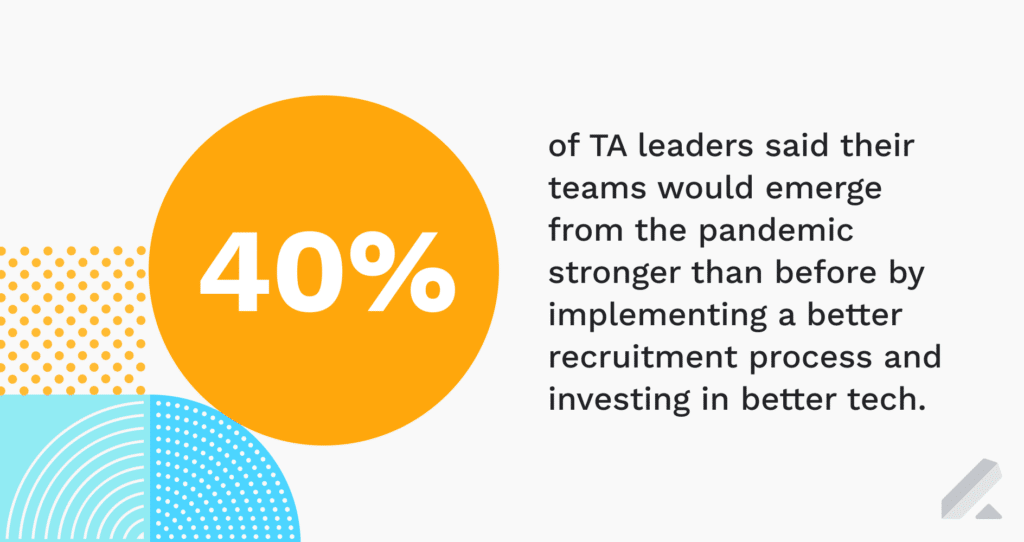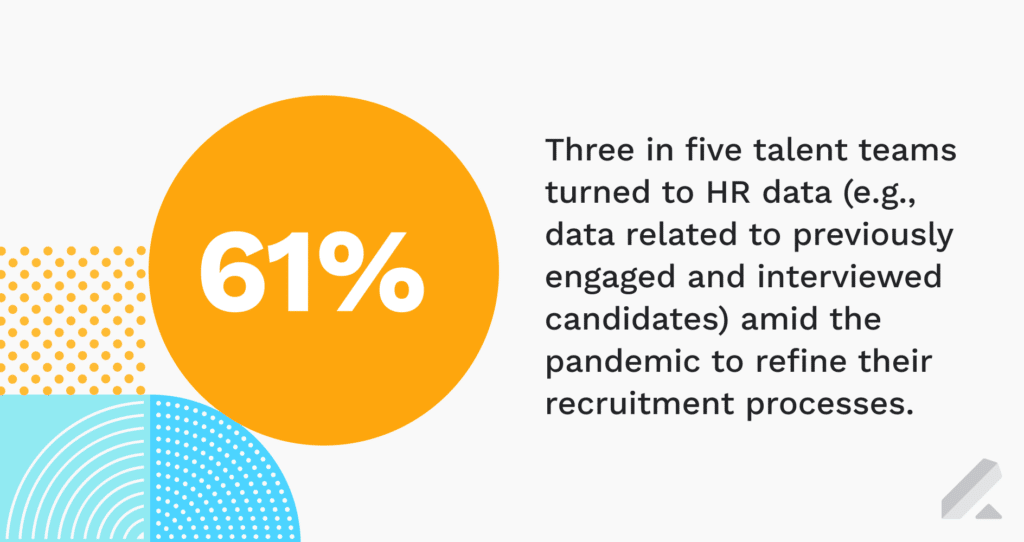Perfection may be the “enemy of good.” However, that shouldn’t stop you from constantly improving each step of the recruitment process to realize greater recruiting and hiring productivity, efficiency, and speed.
Refining the duties for each hiring stakeholder — from talent specialists and operations managers to interview panelists and the HR team — and adjusting your approach to identifying and engaging qualified candidates to get them to accept job offers is paramount today.
In fact, there are many talent acquisition tasks you should regularly put under the microscope to ensure you can effectively convert net-new talent and keep existing employees at your organization for years to come, including:
- The sources (and source origins) you turn to most often to find potential candidates
- The copy (e.g., job description, brand messaging) used in your company’s job postings
- The method you use to review applicants (i.e., manually or in an automated fashion)
- The applicant tracking system (or other recruiting platform) your talent team utilizes
- The way in which you you advance leads in your talent pool and conduct interviews
- The internal mobility program you have in place to retain and reward top performers
In short, it’s a good idea to continually elevate your output with these common talent acquisition-related activities — at both the team and individual-recruiter level — to pinpoint hiring issues and optimize your recruitment strategy.
The good news? You can augment your recruitment process — and enhance your performance — by following a few best practices embraced by leading TA teams today.

3 recruitment process changes that can help you hire smarter and improve operational efficiency
“Recruitment teams may feel at loose ends during a hiring slowdown, but you can use this downtime strategically to level-up your skills and optimize your processes,” former recruiting executive Richard Cho recently wrote for HBR.
With that in mind, here are three ways you can strengthen your talent team’s recruitment process and make continual progress with scaling and growing your business.
1) Invest in a unified, centralized recruiting solution your entire team can use
Speaking with SHRM, PERKS VP of People and Culture Eileen Lee said it’s vital for TA teams to work from the same centralized recruiting database to execute their recruitment plan.
“That way, you can ensure that all of the information regarding your candidates lives in one place and is accessible during all stages of the pipeline,” Eileen explained to the publication.
The issue facing many hiring teams today is the need for a more optimal recruiting database that enables them to work smarter, not harder.
Traditional ATS are the go-to choice for many talent orgs. But the tides are changing.
Countless talent acquisition leaders are now turning to more advanced TA solutions that don’t just act as a repository for basic candidate details and recruiters’ notes.
More specifically, these talent directors are implementing unified platforms with powerful ATS features and robust candidate relationship management (CRM) functionality.
Consider Lever customer Master Charter Schools (MCS):
- The organization reviews roughly 10,000 applications and makes about 500 hires annually. Using an old-school ATS evaluate active candidates’ resumes and cover letters, however, proved far too time- and labor-intensive for MCS’s talent team.
- Moreover, recruiters at MCS needed an advanced and intuitive solution to help them connect with passive prospects whose backgrounds and experience levels aligned with the job specifications for the openings across its network of 24 schools.
- Onboarding LeverTRM as its single source of TA truth enabled MCS’s recruiting staff to implement a multi-channel sourcing strategy that helped it engage leads of interest and advance them in the hiring process quickly and efficiently and, in turn, avoid stagnancy with its recruitment cycle and losing out on top talent.
“With LeverTRM, we can identify where candidates are sitting too long and tighten up our process,” said MCS Sr. Director of Recruitment Operations, Outreach, and Data Anthony Buatti. “It helps us standardize across locations and strategize to get the best talent in the door as quickly as possible.”
2) Understand the constantly evolving jobs market — and what workers want
Aside from securing a single source of hiring truth to bolster your team’s recruitment process, you must also focus on external factors and forces that affect your headcount goals.
Notably, it’s worth paying attention to the ebbs and flows of the jobs market. In particular:
- What job seekers are looking for in prospective employers and new positions today (i.e., what job applicants and sourced candidates tell you about their wants and needs in the interview process)
- What recruiting agencies that work with you hear from candidates in their own outreach and interviews as it relates to things like salary demands, preferred perks/benefits, remote work, and DEI
- What the latest international, national, regional, and local hiring numbers indicate (e.g., if hiring is up or down in markets where you’re headquartered; what percentage of hires are fully remote)
Arguably the biggest employment trend today is the desire to work remotely.
“The freedom (often the imperative) to work remotely and to manage one’s own schedule has increased employees’ expectations that they can exert considerable control over the design of their jobs,” Gartner recently wrote for HBR.
It’s certainly on your C-suite to determine if they want to embrace a remote/hybrid workforce.
That said, keeping your ear to the ground as it pertains to WFH requests from candidates and learning how other companies — including competitors — adapt their businesses to accommodate the remote-work push is certainly worth the time and energy.
Doing so could impact your recruitment process: where you source prospects, the messaging you share with them, and which archived candidates you engage/reengage for roles.

3) Identify issues with your recruitment process and “funnel flow” to fix
You get a complete talent acquisition suite to aid your CRM strategy. You regularly assess employment figures and trends to keep up with changes in the hiring landscape.
But what about the nitty-gritty details related to your TA org’s recruitment process?
Examining your team and individual talent specialists’ performance at a high level certainly helps with long-term goal-setting and planning to meet hiring quotas.
However, analyzing your recruiting activities at a granular level can lead to big improvements with daily processes — and better-quality hires. Assess how you can better:
- Liaise closely with human resources and hiring managers: That way, you can work with them to pinpoint persistent (and costly) communication problems (e.g., lack of automated reminders and notifications being sent to those stakeholders) you can then remedy.
- Keep candidate experience top of mind: Ensuring candidates move seamlessly through your funnel — from when you source them via job boards or social media (see: LinkedIn) to when they’re onboarded or archived — is essential to providing a best-in-class CX.
- Identify ‘slow’ stages of your hiring efforts: Perhaps it takes too long for HR to complete background checks. Or, maybe the interview process could use fixing (e.g., have all panelists join a single video interview as opposed to conducting many individual video calls).
There are plenty of areas to focus on to elevate your recruiting effectiveness.
The point is you can’t improve what you don’t analyze and take action on. So, dig deep into your recruitment process regularly to make sure your talent team is as productive as possible.
Download our talent relationship management eBook to learn how you and your recruiting org can elevate your hiring efforts with a TRM mindset and a complete TA suite.



